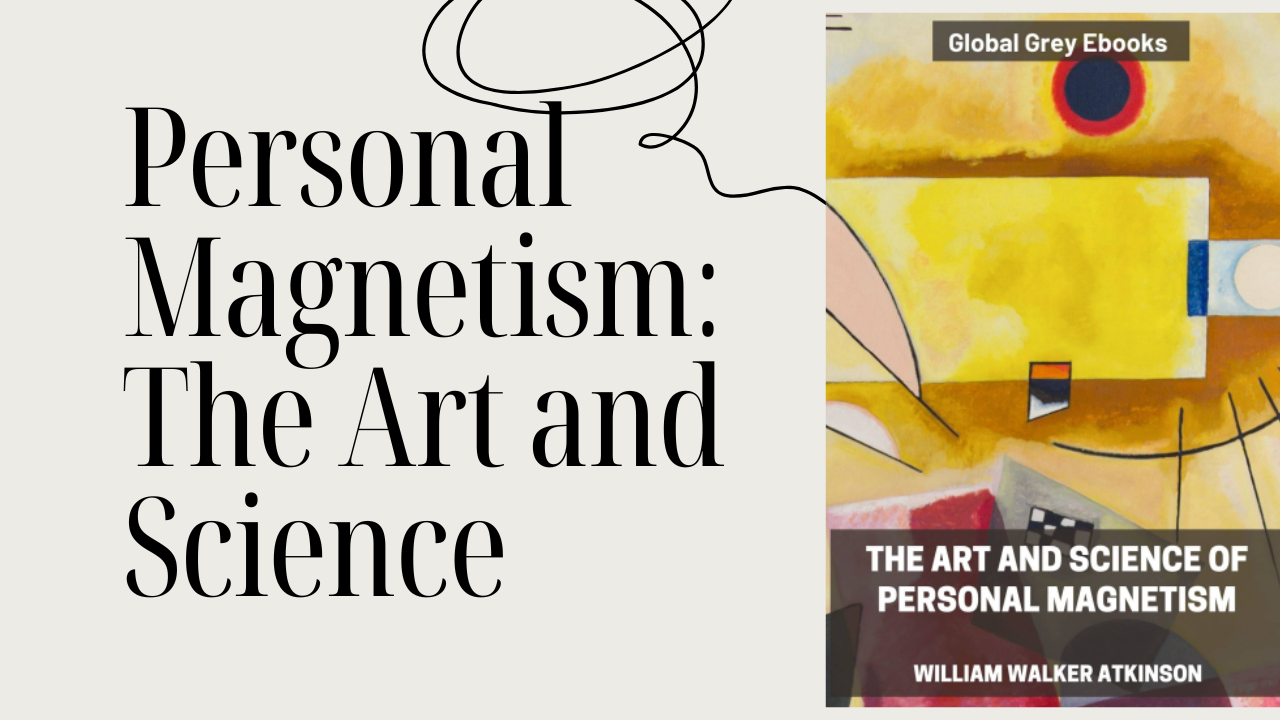
“The Art and Science of Personal Magnetism” by William Walker Atkinson, writing as Theron Q. Dumont, explores the concept of personal magnetism as a combination of mental and physical forces. Published in 1913 and re-released as an ebook in 2021, the book presents a series of lessons designed to cultivate and project this magnetism. Atkinson explains the interplay between mental thought-waves and physical nerve-force, outlining exercises to generate, distribute, and consciously project this combined energy. The text covers topics such as mental attitudes, magnetic currents, direct commands, and even magnetic self-defense. Atkinson also touches on the concept of “corporeal magnetism,” or magnetism conveyed through touch and the work finishes with advice from Julie, the woman who runs Global Grey where this book was published, about donations and protecting against being ripped off buying falsely priced ebooks.
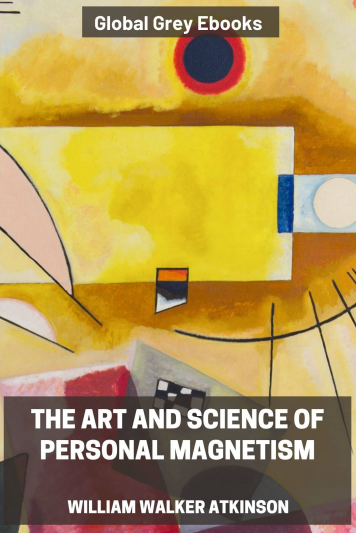
FAQ on Personal Magnetism
- What is personal magnetism, and does everyone possess it?
- Personal magnetism is a force or influence that individuals generate and project, affecting the minds of others. Contrary to the belief that only certain individuals possess it, everyone possesses personal magnetism to some degree. It can manifest as either attraction or repulsion. Even those who seem “un-magnetic” possess it but may unknowingly use it negatively, repelling people instead of attracting them. Through knowledge and practice, anyone can increase the degree and strengthen the power of their personal magnetism.
- What are the two main phases of personal magnetism, and how do they work?
- Personal magnetism has two main phases: mental and physical. The mental phase involves holding certain mental states to charge one’s mental atmosphere and consciously projecting a mental current from the brain using will. The physical phase involves generating and distributing nerve-force within the body through specific breathing and tensing exercises. Both phases are coordinated and essential for manifesting strong personal magnetism.
- How does one cultivate a positive mental atmosphere, and why is it important?
- Cultivating a positive mental atmosphere involves consciously choosing and maintaining mental states like courage, hope, and self-esteem. The character of one’s mental atmosphere directly influences how others perceive and react to them. By focusing on positive mental attitudes and restricting negative ones (fear, self-doubt), individuals can create a personal atmosphere that inspires confidence, trust, and positive feelings in others. Regular self-assessment and consistent “feeding” of the mind with positive influences are crucial.
- What role does the will play in personal magnetism, and how can it be developed?
- The will is the mental faculty by which one is able to do things and consciously exert one’s influence. The will is essential for projecting mental currents and physical magnetism. It acts as a directing force, channeling and amplifying mental and physical energies. The will is strengthened through belief in one’s ability to influence others, and through practice and persistent effort. Regular exercises, such as visualizing the desired outcome and commanding one’s inner resources to act, can significantly enhance the power of the will.
- How can one generate and distribute nerve-force to enhance physical magnetism?
- Nerve-force generation involves absorbing an extra amount of nerve-force from the atmosphere through specific forms of rhythmic breathing and distributing that force to the nervous system. This is achieved by consciously “acting out” a breath-rhythm that nature uses after mental, emotional, or physical strain. This rhythm typically includes a long, drawn-out sigh, followed by deep, slow, and deliberate breathing. Nerve-force is then distributed throughout the body by incorporating “stretching” or tensing exercises, focusing on slow, calm movements rather than strenuous activity. These practices vitalize the body and build a reservoir of nerve-force for use in personal magnetism.
- What are magnetic currents, and how do they affect others?
- Magnetic currents are the flows of energy formed by the combination of physical and mental force. These currents are composed of magnetic waves that radiate from an individual’s personal atmosphere. When these waves come into contact with others, they can influence their mental state, creating vibrations that correspond to those of the person sending the magnetism. Physical magnetism provides the energizing “body” of these currents, while mental magnetism provides the quality or “color.”
- What is the “direct flash” method, and how is it used to influence others?
- The “direct flash” is a technique for projecting a positive influence by using a mental command backed by combined physical and mental magnetism. It involves forming a direct command in the mind, accompanied by a mental picture of the desired action from the other person, mentally gathering both forms of magnetism into one force, and then deliberately discharging the “flash” with the will. Exercises like gazing at one’s reflection in a mirror and practicing commands (e.g., “I am stronger than you!”) are used to develop and refine this ability.
- How can one defend against the negative influences of others’ personal magnetism?
- Defending against the negative influences of others’ magnetism involves employing a “shield of denial.” This technique consists of mentally denying the power of the other person, affirming one’s own immunity to their influence. Statements such as “I deny your power” or “You have no influence over me” are used to create a mental barrier against the incoming magnetic forces. This method does not destroy the other person’s magnetism, but rather renders it ineffective against the individual using the shield, and those they wish to protect.
A Study Guide to the Art and Science of Personal Magnetism
Review of Key Concepts
- Personal Magnetism: The inherent force possessed by every individual that can attract or repel others, influenced by both mental and physical aspects.
- Mental Magnetism: The aspect of personal magnetism derived from one’s mental states and projected through the will, creating a personal atmosphere that influences others.
- Physical Magnetism (Nerve-Force): A vital energy within the nervous system, which can be consciously generated, stored, and projected to energize thoughts and actions.
- Personal Atmosphere (Aura): The field of magnetic influence surrounding each individual, colored by their mental and physical state, which affects others coming within its range.
- Recuperative Breath-Rhythm: A natural breathing pattern used to restore nerve-force to the depleted system, involving a long sigh and slow, deep breaths.
- Nerve-Force Distribution: A process of stretching and tensing muscles to distribute absorbed nerve-force throughout the body, vitalizing and stimulating various parts.
- Mental Attitudes: Defined and firmly held mental states that impress themselves upon everything around the individual, coloring their voice, walk, appearance, and overall disposition.
- Direct Flash: A mental command accompanied by a mental picture of the desired action on the part of the other person, energized by the combined physical and mental magnetism.
- Positive Aura: A desired personal atmosphere to be cultivated that can influence a crowd or group of people all at once.
- Shield of Denial: A mental process to deny the power of another person’s direct flash.
- Corporeal Magnetism: The conveyance of personal magnetism through physical touch, such as a handshake or laying hands on someone’s shoulders.
Quiz
- Explain the difference between positive and negative personal magnetism.
- Describe how thought energy can extend beyond the limits of one’s brain.
- What are the two coordinated manifestations of mental power that influence the mental phase of personal magnetism?
- How does the character of one’s mental states affect their mental atmosphere?
- Explain how one can increase the effect of their mental vibrations using will.
- Describe the process of generating nerve-force through rhythmic breathing.
- Explain how the exercises of stretching, twisting, and bending contribute to nerve-force distribution.
- How can the will be used to consciously project physical magnetism?
- What two main ideas are involved in the projection of physical magnetism by the will?
- Explain the concept of the “direct flash” and its components.
Quiz Answer Key
- Positive personal magnetism attracts others, while negative personal magnetism repels them. It’s all a matter of the use of the power.
- The human brain generates energy during thinking, which produces heat and affects a “thought-atmosphere” extending beyond the brain. This energy can register an effect upon the brains of others coming within this field of energy.
- The two coordinated manifestations of mental power are: (1) holding certain mental states to charge the mental atmosphere, and (2) consciously projecting the mental current from the brain centers through the will.
- The character of one’s mental states directly influences their mental atmosphere, creating vibrations that affect those nearby, either positively (e.g., hopeful) or negatively (e.g., gloomy).
- Using one’s will to project and force outward mental vibrations from the brain will increase the strength and energize the vibrations of one’s mental atmosphere.
- Generating nerve-force involves absorbing nerve-force from the atmosphere through special forms of breathing, combined with the distribution of this energy to the great centers of the nervous system.
- Stretching, twisting, and bending exercises distribute nerve-force throughout the body, vitalizing and stimulating various parts, similar to nature’s way of distributing nerve-force after exertion.
- One can consciously project physical magnetism by believing in one’s power to do so and then willing or commanding the force to be projected.
- The projection of physical magnetism by the will involves: (1) believing in one’s power to project the force, and (2) the actual willing or commanding of the force to be projected.
- The “direct flash” is a method of projecting positive influence consisting of: (1) forming a mental command with a picture of the desired action, (2) gathering combined mental and physical magnetism, and (3) deliberately discharging the flash by the will.
Essay Questions
- Discuss the importance of developing both physical and mental magnetism in achieving personal magnetism.
- Analyze the role of mental attitudes in creating a strong personal atmosphere and influencing others.
- Explain the relationship between nerve-force, rhythmic breathing, and muscle tensing in the development of physical magnetism.
- Describe the ethical considerations in using personal magnetism to influence others.
- Evaluate the effectiveness of the techniques outlined in the book for cultivating personal magnetism in modern society.
Glossary of Key Terms
- Personal Magnetism: An inherent force possessed by every individual, influencing attraction or repulsion in others.
- Mental Magnetism: The mental aspect of personal magnetism, involving thoughts, beliefs, and the will.
- Physical Magnetism (Nerve-Force): A vital energy within the nervous system that can be generated, stored, and projected.
- Personal Atmosphere (Aura): The field of magnetic influence surrounding an individual, reflecting their mental and physical state.
- Telepathy: The ability to transmit thoughts to another person from afar.
- Recuperative Breath-Rhythm: A natural breathing pattern for restoring nerve-force.
- Nerve-Force Distribution: Stretching and tensing muscles to distribute absorbed nerve-force.
- Mental Attitudes: Defined and held mental states influencing behavior and atmosphere.
- Direct Flash: A mental command energized by combined physical and mental magnetism.
- Positive Aura: A desired personal atmosphere to be cultivated that can influence a crowd or group of people all at once.
- Shield of Denial: The mental process to deny the power of another person’s direct flash.
- Corporeal Magnetism: The conveyance of personal magnetism through physical touch.
- Occultists: People who study the ancient arts of magic.
- Clairvoyant: A person who claims to have the supernatural ability to perceive events in the future or beyond normal sensory contact.
- Aura: A supposed emanation surrounding a person or object and thought to be discernible as an outline of color.
- Dynamic: (of a person) positive in attitude and full of energy and new ideas.
- Static: Lacking in movement, action, or change, especially in a way viewed as undesirable or uninteresting.
- Initiative: The ability to assess and initiate things independently.
- Assertiveness: Having or showing a confident and forceful personality.
- Retreativeness: The practice of withdrawing (oneself) from something.
- Fickleness: Changing frequently, especially as regards one’s loyalties or affections.
- Ether: A substance supposed to occupy the region of space beyond the atmosphere.
- Proteges: A person who is guided and supported by an older and more experienced or influential person.




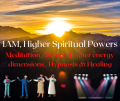



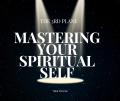


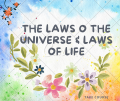










0 responses on "Personal Magnetism: The Art and Science"